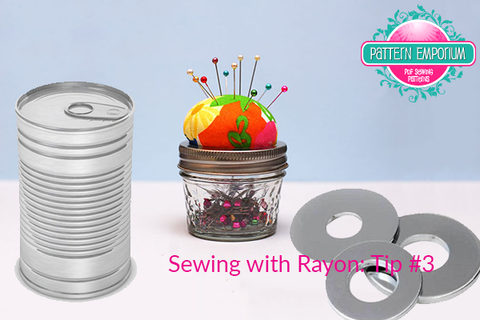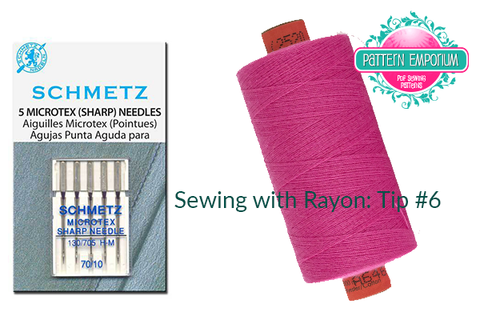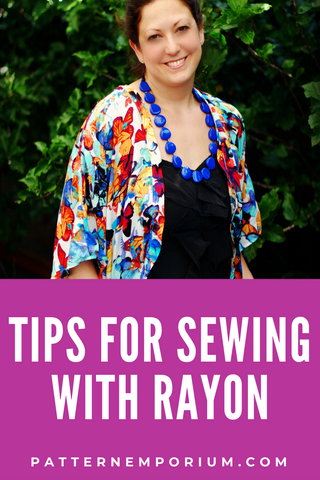Your Cart is Empty
Tips for Sewing with Rayon
4 min read
So, you want to try sewing with rayon? Why wouldn’t you want to experiment and explore the range of bright and vivid possibilities from these threads, creating a fun, breezy collection of flowing pieces? The only problem –you're not sure what you need to do to successfully use rayon thread for sewing. By following the steps outlined below, you will eliminate a lot of the frustration & anxiousness people sometimes feel when sewing with fluid fabrics like rayon, silk and silk-like fabrics.
What is Rayon Thread for Sewing?
Rayon thread has been used for sewing for centuries, ever since it was first introduced to the masses in France during the late 1800s, and gained traction in the UK & US in the early 1900s. In fact, it was the first fibre ever made by humankind, and the name ‘Rayon’ was actually given by the Americans from the French word for a ‘ray of sunlight’, which they felt best reflected the striking colours captured within the fabric.
Rayon is created by blending a range of natural and manufactured products, consisting of regenerated celluloses and plant fibres, providing a similar look and feel to silk. Elements like wood pulp are broken down using a specialised chemical solution, with the liquid eventually extracted and the solid remnants collected to be shredded and aged.
They then progress to be dissolved further by another solution, aged, filtered, and placed into an acid bath. The final result is then spun and stretched repeatedly until it makes the rayon thread for sewing. This leaves sewing with rayon as being a very strong choice, but also smooth when placed through a sewing machine.
Sewing with rayon thread also has a range of benefits, including:
- It is unlikely to pill, except perhaps when sewing over a knit fabric
- The fabric takes well to a range of dyes, increasing the potential for a host of colours and designs
- Resists abrasion while still having a nice feel
- Can take hard use without losing strength
Rayon sewing thread is often used for sewing projects like high-end clothing, pillows and handbags where you need a smooth thread that won't fuzz or shred over time. Since it resists abrasion well, it's also great for stitching upholstery as well as sewing on buttons, since this kind of sewing thread doesn't stretch.
Some people who are not familiar with sewing with rayon may find it difficult at first because they notice that their sewing machine has a harder time sewing through the fibre than another type of sewing thread, such as cotton sewing thread, so you may need to adjust sewing machine tension.
HOW TO SEW RAYON
1. WASH YOUR FABRIC:
Rayon shrinks so you need to pre-wash & then dry & iron before you sew with it.
2. LAYING YOUR FABRIC:
When you cut your fabric, lay an old, clean sheet or some cotton fabric from your stash (that you don’t mind cutting) on your table first. Then lay your fabric on top.
Out of all the tricks to handling frustratingly slinky fabrics, I found this one the most helpful.

3. PINS & WEIGHTS:
Using pins AND weights to secure the pattern will help fabric from moving around. You can simply use cans from your pantry (just be careful of any rust).
Use very sharp pins so you don’t snag the fabric.
Tip: if you buy pins with black paper inside the box, leave the black paper inside. It helps keep your pins sharp. (Google: ‘Crown Fox Pearl Pins’).

4. CUTTING YOUR FABRIC:
Whether you are using a rotary cutter or scissors, sharp is the key here.

5. INTERFACING/FUSING:
Use a very lightweight interfacing.
My preferred method: I iron the cut fabric pieces onto uncut interfacing & then cut around the fabric, rather than cut my interfacing pieces to size first.
6. NEEDLE & THREAD:
Use a fresh, very sharp, fine needle. I use a ‘Schmetz’ Microtex Sharp Needle (70/10).
Use a good quality thread. (My preference for my sewing machine is Rasant).

7. MACHINE FOOT:
Most people find that their normal machine foot works well. Others prefer a ‘walking foot’.
8. WHEN THE INSTRUCTIONS SAY TO PIN:
SERIOUSLY, PIN! It will ruin your close relationship with your unpicker, but it’s worth it.
Also, lay your fabric down on a flat surface to pin seams together. Something so simple makes a HUGE difference.
A cautionary note: DO NOT SEW OVER YOUR PINS. Not only will this blunt & potentially break the needle. The last thing you need is a trip to the hospital to extract needle shards from your eye!
9. FABRIC SLIDING AS YOU SEW:
One of the main issues with sewing fluid is your fabric sliding. It’s hard to avoid.
Use lots of pins (very sharp & within the seam allowance so you don’t snag your fabric).
LASTLY,
Take your time when you sew. Don’t rush sewing with rayon or other fluid fabrics. Sew a small amount & then re-adjust your fabric making sure that your raw edges remain aligned.
Learn More on How to Sew with Rayon from the Team at Pattern Emporium
When you are looking to pick a rayon project, you need to consider how the material and design patterns will work together in the final use of the garment.
As you are still starting out with learning how to sew rayon, it pays to learn from professionals within the industry. At Pattern Emporium, we offer a range of resources, on-trend designs and designs to help you learn more on becoming more familiar with rayon thread for sewing, as well as a selection of other fabrics and techniques, including woven fabric and dress patterns.
Review our selection available today, or if you would like to discuss your particular situation in more detail, please contact us directly by completing our simple online enquiry form, and we will get back to you as soon as possible.

Subscribe
Sign up to get the latest on sales, new releases and more …





















